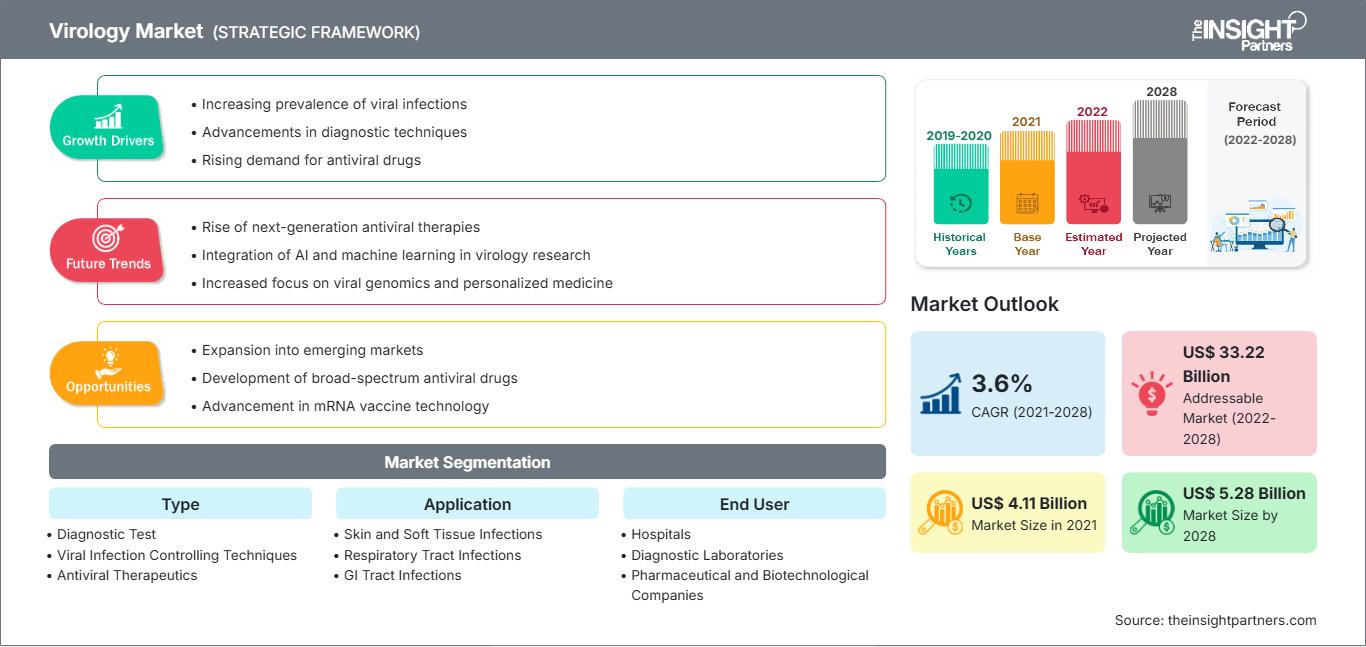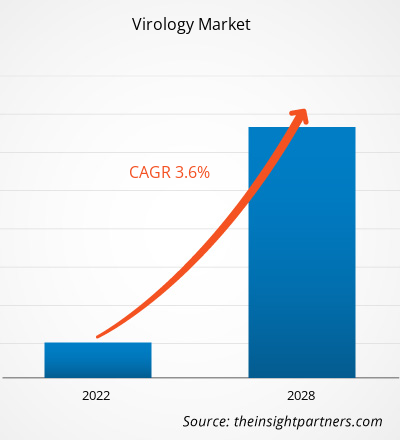페이지 업데이트됨 :
Jun 2024
바이러스학 시장은 2021년 41억 827만 달러에서 2028년 52억 7,648만 달러로 성장할 것으로 예상되며, 2021년부터 2028년까지 연평균 성장률 3.6%를 기록할 것으로 예상됩니다.
바이러스학은 의료 시스템의 중요한 분야 중 하나입니다. 백신 개발, 진단, 치료법 등 다양한 분야에 광범위하게 응용되고 있습니다. 바이러스학 시장 참여자들은 시장 경쟁에서 살아남기 위해 끊임없이 제품 혁신과 개발에 참여하고 있습니다. 다양한 제품 혁신 가능성을 모색하고 있습니다. 예를 들어, COVID-19의 경우, 시장 참여자들은 백신, 진단 키트, 기타 관련 제품 및 서비스 개발에 상당한 투자를 하고 있습니다. 다음은 바이러스 시장과 관련된 몇 가지 시장 동향입니다.
- 2021년 8월, 미국 식품의약국(FDA)은 화이자-바이오엔테크 COVID-19 백신으로 알려진 최초의 COVID-19 백신을 승인했습니다. 이 백신은 ComiRNAty(Koe-mir’-na-tee)라는 이름으로 판매될 예정입니다. 이 백신은 16세 이상의 COVID-19 감염 예방을 위해 개발되었습니다. 긴급 사용 승인(EUA)도 받았습니다.
- 2021년 4월, CerTest Biotec은 BD MAX 시스템용 CE 마크가 부착된 COVID-19 진단 검사를 출시했습니다.
- 2020년 5월, Bio-Rad는 COVID-19 총 항체 검사에 대한 FDA 긴급 사용 승인을 받았습니다.
- 2020년 5월, Aalto Bio Reagents는 새로운 재조합 진핵생물 SARS-CoV-2 S1-S2 스파이크 단백질을 출시했습니다.
따라서 제품 혁신을 통한 시장 참여자들의 적극적인 참여와 다양한 국가의 정부 지원은 바이러스학 시장의 성장을 촉진합니다.
요구 사항에 맞게 이 보고서를 사용자 정의하십시오.
이 보고서의 일부, 국가 수준 분석, Excel 데이터 팩을 포함하여 모든 보고서에 대한 사용자 정의를 무료로 받을 수 있을 뿐만 아니라 스타트업 및 대학을 위한 훌륭한 제안 및 할인을 이용할 수 있습니다
바이러스학 시장: 전략적 통찰력

- 이 보고서의 주요 주요 시장 동향을 확인하세요.이 무료 샘플에는 시장 동향부터 추정 및 예측에 이르기까지 데이터 분석이 포함됩니다.
요구 사항에 맞게 이 보고서를 사용자 정의하십시오.
이 보고서의 일부, 국가 수준 분석, Excel 데이터 팩을 포함하여 모든 보고서에 대한 사용자 정의를 무료로 받을 수 있을 뿐만 아니라 스타트업 및 대학을 위한 훌륭한 제안 및 할인을 이용할 수 있습니다
바이러스학 시장: 전략적 통찰력

- 이 보고서의 주요 주요 시장 동향을 확인하세요.이 무료 샘플에는 시장 동향부터 추정 및 예측에 이르기까지 데이터 분석이 포함됩니다.
시장 분석
최소 침습 및 비침습 미용 시술 도입 증가로 바이러스 시장 성장 견인
인간 면역결핍 바이러스(HIV), 독감 바이러스, 지카 바이러스, 에볼라 바이러스, SARS-CoV-2, 소아마비 바이러스와 같은 바이러스는 전 세계적으로 많은 사람들을 감염시키고 있습니다. 바이러스가 지속적으로 돌연변이를 일으키고 진화함에 따라 약물 내성은 인간과 동물의 바이러스 감염 관리에 있어 주요 과제가 되고 있습니다. 바이러스는 유형에 따라 다양한 매개체를 통해 전파됩니다. 예를 들어, 일부 바이러스는 독감, 감기, 호흡기 세포융합 바이러스 감염과 같은 호흡기 바이러스성 질병을 유발하며 기침이나 재채기를 통해 생성되는 비말을 통해 전파됩니다. 반면 일부 위장관 바이러스성 질병은 감염된 사람의 대변과의 직접 접촉이나 오염된 음식이나 물을 통해 전파됩니다. UNAIDS Global HIV & 영어: AIDS 통계에 따르면 2020년에 전 세계적으로 3,770만 명 이상이 HIV에 감염되었습니다.
국제 바이러스 분류 위원회(ICTV)는 2020년 2월에 COVID-19를 유발하는 신종 코로나바이러스를 중증 급성 호흡기 증후군 코로나바이러스 2(SARS-CoV-2)로 선언했습니다. 이 바이러스는 발병 이후 몇 차례 돌연변이를 겪었고, 이로 인해 COVID-19 팬데믹의 심각성이 더해졌습니다. 예를 들어, 질병통제예방센터(CDC)의 COVID-19 추적 데이터에 따르면 2021년 8월 기준 10만 명당 7일 발생률은 299.4이고, 미국에서는 164,952건 이상의 새로운 사례가 보고되었습니다. 또한, 유럽 질병예방통제센터에 따르면 2021년 8월 기준 유럽 경제 지역(EEA)의 COVID-19 총 사례 수는 약 36,307,572명에 달했습니다. 따라서 바이러스 감염의 유병률이 증가함에 따라 바이러스학 시장이 성장하고 있습니다.
바이러스학 시장
The Insight Partners의 분석가들은 예측 기간 동안 바이러스학 시장에 영향을 미치는 지역별 동향과 요인을 면밀히 분석했습니다. 이 섹션에서는 북미, 유럽, 아시아 태평양, 중동 및 아프리카, 그리고 중남미 지역의 바이러스학 시장 세분화 및 지역별 분포도 살펴봅니다.
바이러스학 시장 보고서 범위
바이러스학 시장 참여자 밀도: 비즈니스 역학에 미치는 영향 이해
바이러스학 시장은 소비자 선호도 변화, 기술 발전, 그리고 제품의 효능에 대한 인식 제고 등의 요인으로 인한 최종 사용자 수요 증가에 힘입어 빠르게 성장하고 있습니다. 수요가 증가함에 따라 기업들은 제품 및 서비스 확장, 소비자 니즈 충족을 위한 혁신, 그리고 새로운 트렌드를 적극 활용하며 시장 성장을 더욱 가속화하고 있습니다.

- 을 얻으세요 바이러스학 시장 주요 주요 플레이어 개요
유형 기반 인사이트
바이러스학 시장은 유형에 따라 진단 검사, 바이러스 감염 관리 기술, 항바이러스 치료제, 인터페론으로 세분화됩니다. 2021년에는 진단 검사 부문이 시장 점유율 1위를 차지할 것으로 예상되며, 바이러스 감염 관리 기술 부문은 2021년부터 2028년까지 가장 높은 연평균 성장률(CAGR)을 기록할 것으로 예상됩니다.
응용 분야 기반 인사이트
응용 분야를 기준으로 시장은 피부 및 연조직 감염, 호흡기 감염, 위장관 감염, 성병, 요로 감염 등으로 세분화됩니다. 2021년에는 호흡기 감염 부문이 시장에서 가장 큰 점유율을 차지할 것으로 추산되며, 2021~2028년 동안 가장 높은 CAGR을 기록할 것으로 예상됩니다.
바이러스 시장에서 활동하는 회사들은 전 세계적으로 변화하는 고객 수요를 충족하기 위해 제품 혁신 전략을 채택하는 데 중점을 두고 있으며, 이를 통해 글로벌 시장에서 브랜드 이름을 유지할 수 있습니다.
바이러스 시장 - 세분화
유형별
- 진단 검사
- DNA 바이러스 검사
- RNA 바이러스 검사
- 기타
- 바이러스 감염 관리 기술
- 능동적 예방
- 수동적 예방
- 항바이러스 치료제
- 살바이러스제
- 항바이러스제
- 면역 조절제
- 인터페론
적용 분야별
- 피부 및 연조직 감염
- 호흡기 감염
- 위장관 감염
- 성병
- 요로 요로 감염
- 기타
최종 사용자별
- 병원
- 진단 검사실
- 제약 및 생명공학 회사
- 연구 및 학술 기관
지역별
- 북미
- 미국
- 캐나다
- 멕시코
- 유럽
- 프랑스
- 독일
- 이탈리아
- 영국
- 스페인
- 유럽 기타 지역
- 아시아 태평양
- 중국
- 인도
- 한국
- 일본
- 호주
- 기타 지역 APAC의
- 중동 및 아프리카
- 남아프리카
- 사우디아라비아
- UAE
- 기타 MEA
- 남미 및 중앙아메리카
- 브라질
- 아르헨티나
- 기타 SCAM
회사 프로필
- Abbott
- Johnson & Johnson Services, Inc.
- F. Hoffmann-LA Roche Ltd.
- Thermo Fisher Scientific, Inc.
- Qiagen
- Illumina, Inc.
- Siemens AG
- GlaxoSmithKline Plc
- Gilead Sciences, Inc.
- AbbVie, Inc.pyright 이름은 각 웹사이트에 표시됩니다.
- 과거 분석(2년), 기준 연도, CAGR을 포함한 예측(7년)
- PEST 및 SWOT 분석
- 시장 규모 가치/거래량 - 글로벌, 지역, 국가
- 산업 및 경쟁 환경
- Excel 데이터세트
최근 보고서
사용 후기
구매 이유
- 정보에 기반한 의사 결정
- 시장 역학 이해
- 경쟁 분석
- 고객 인사이트
- 시장 예측
- 위험 완화
- 전략 기획
- 투자 타당성 분석
- 신흥 시장 파악
- 마케팅 전략 강화
- 운영 효율성 향상
- 규제 동향에 발맞춰 대응
고객































87-673-9708

ISO 9001:2015





 무료 샘플 받기 - 바이러스학 시장
무료 샘플 받기 - 바이러스학 시장